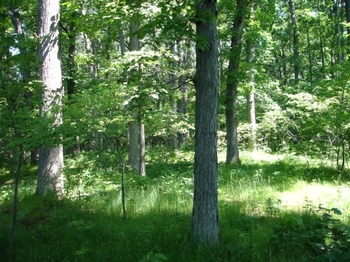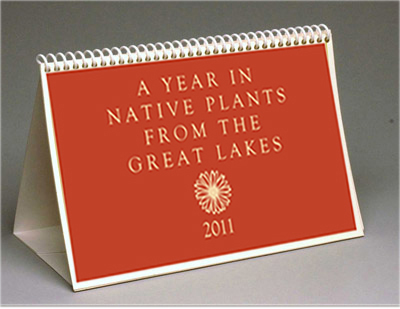Ann Arbor Native - Oak openings and their kin

Oak barrens, a close cousin of Oak Openings
Photo by Mike Kost, MNFI
No, an oak opening is not a wooden door. An oak opening, or some other similar oak savanna-type habitat along the prairie to oak forest continuum, was a cross between a prairie and an oak woodland. Prior to their development by settlers from the Eastern United States, Ann Arbor, and much of southern Michigan (especially that portion that wasn’t wetland), was covered by oak openings and their kin.
Prized by settlers for their beauty, as well as the wood they provided and the relative ease of their settlement due to the openings between the trees, they were quickly and thoroughly developed. The settlers also didn’t value the use of fire like the Native Americans of the area did either, so as they took over more of the land, even those areas that weren’t developed weren’t burned and gradually filled in to become forest. So what did the oak openings look like? Let’s take a walk back in time to learn more.
Oak Openings, as defined by the Michigan Natural Features Inventory, are “fire-dependent savannas dominated by oaks, having between 10 and 60 percent canopy, with or without a shrub layer. The predominantly graminoid ground layer is composed of species associated with both prairie and forest communities." For those of you following along, graminoid means plants such as grasses, sedges or rushes.
There were also many, many wildflowers mixed amongst the graminoids. Fire was required to maintain the open character of the habitat, and Native Americans regularly burned the openings to keep them open for hunting and travel and to maintain the plant species upon which many of their medicines were based. Other similar habitats were oak barrens, bur oak plains and dry-mesic southern forest and mesic southern forests.
What the combination of sun and shade offered was a range of conditions that supported a range of plants, from prairie and forest species, as well as some species specialized to the special conditions offered by the openings. In turn, many wildlife species also found these habitats to be optimal, and called them home. Another good writeup about oak savannas can be found at the Wisconsin DNR website.
As settlers and travelers passed through southeastern Michigan, they were taken with the beauty of the oak openings.
“The monotonous landscape ceases near Ann Arbor; and here the country becomes more interesting as one approaches the high plateau. The dense forests disappear and lakes surrounded by pretty hills and parklike woods, which the Americans call 'oak openings' meet the traveler’s eye… where the trees stand a few paces apart and where the ground is overgrown with luxurious grasses. Passage is obstructed neither by bushes or by fallen trees. Small knolls alternate with lovely little valleys…No park laid out by human hands could compare with this natural setting,” wrote Karl Niehard, editor of the Amerikanisches Magazin, 1834.
Unfortunately, there is less than 1 percent of the original area of these beautiful landscapes left today, so we won’t be able to experience what Karl did, but the Toledo area is home to an outstanding metropark complex, and caretakers are actively working to restore the oak openings that exist down there.
If you want to see something closer, the Oak Openings Garden in the Nichols Arboretum is a cooperative effort between the Arb and the Ann Arbor Chapter of the Wild Ones. Located just beyond the Peony Garden, the Oak Openings Garden is a growing collection of plants that would be found in oak openings. Grasses, sedges, wildflowers and even the occasional oak sapling can be found in beds along the edge, and expanding backward to form a more natural setting. There are approximately 30 to 40 species currently in the garden, with the goal of expanding the species count to include many more, including some of the rarer species that aren’t easily found in area wild places.
If you have an oak tree in your yard, or nearby, you may be lucky enough to have some plants native to oak openings in your yard. Take a look in the spring and see what you can find.
In my yard, all I have left is a few asters. Welcome to November!

Native Plants Desktop Calendar 2011
Photo by Melanie Boyle
On another Native Plant matter, I happened to meet Melanie Boyle in Kolossis Printing the other day. She has put together a very attractive desktop calendar for 2011 titled “A Year in Native Plants from the Great Lakes”. Her website is http://www.cleverlotus.com/.
In her words, the calendar “is currently available at the Ann Arbor Art Center, Downtown Home and Garden, Matthaei Botanical Gardens and The Garden Mill in Chelsea. It is $20. The calendar images include Flowering Dogwood, Spring Beauty, Purple Pitcher Plant and many more. The images are original designs, cut by hand from paper. Once scanned, I add colour to the image digitally, working in a printmaking method of layers of separate colour. For my cards, I laser print the image on Japanese printmaking paper. So, my work moves between handmade and digital processes.” In my words, the images are really interesting, and I liked it a lot. Go pick one or two up for yourselves.
Don’t let the weather and grey skies get you down. Get out and enjoy nature, everyone!
Rick is a local landscape architect with a special interest in all things natural, including native plants and the critters that eat them. You can contact him at yourland1824@gmail.com.


Comments
vkg
Tue, Nov 16, 2010 : 5:49 p.m.
There's an absolutely enormous burr oak on Sycamore Place (a small street in Lower Burns Park). My friend the landscape architect says it's a couple hundred years old and that the wide canopy indicates that before houses were ever built here in Ann Arbor there was a savannah in this location. tx for the article.
A2K
Tue, Nov 16, 2010 : 2:46 p.m.
Interesting article, thank you :O)